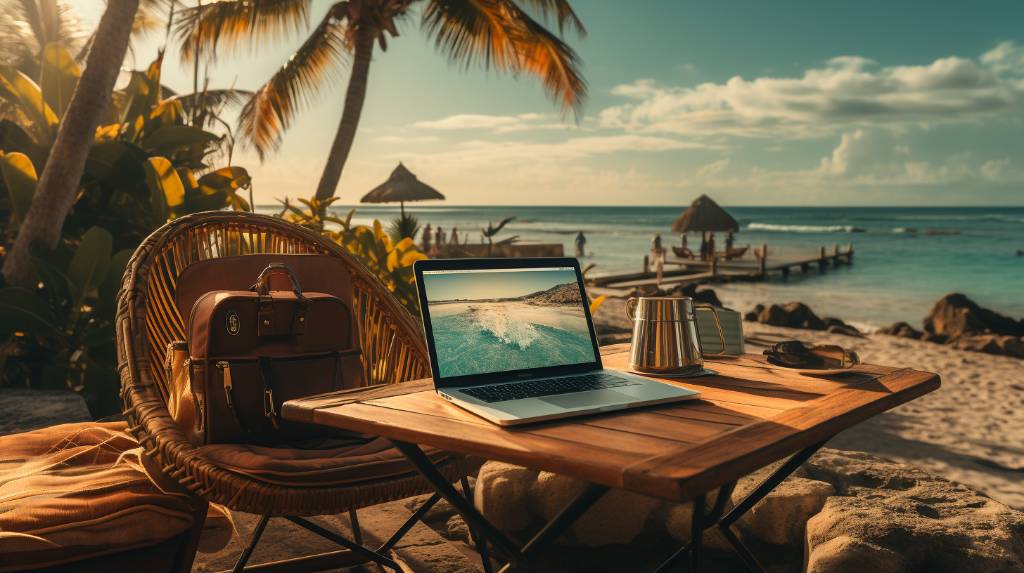Welcome to the digital age where geographical boundaries don’t limit your work capabilities or lifestyle choices. Have you ever dreamt of swapping your 9—to—5 cubicle for the freedom of a sandy beach in Bali or a cozy cafe in France, all while honing your professional skills and sustaining an income? If you nodded a resounding ‘yes’, you are on the threshold of becoming a ‘Digital Nomad.’ Buckle up as we prepare to navigate the fascinating world of digital nomadism — a realm where work meets wanderlust. This comprehensive guide will shed light on the essentials, including the ins and outs, challenges, rewards, and all the robust digital tools that you’ll need to successfully break into this unparalleled lifestyle. So grab your virtual passport for we are embarking on an exciting journey towards working remotely and experiencing the world on your own terms.
Introduction to Digital Nomadism
Breaking into the domain of digital nomadism poses a fascinating realm of possibilities. With the world becoming more interconnected, and remote work increasingly common, the concept of being a ‘digital nomad’ has established itself as a mainstream lifestyle choice.
The term ‘digital nomad’ might sound like something borrowed from a science fiction novel, but in reality, it’s the embodiment of a modern, technology-driven lifestyle that many aspire to. Simply put, a digital nomad is someone who leverages the power of internet and digital tools to work away from traditional office environments, choosing instead to work on-the-go. This lifestyle choice has been enabled by advances in digital communication technologies which makes telecommuting possible for a range of jobs.
Choosing digital nomadism means choosing a life of freedom to work from anywhere you desire, be it a cozy coffee shop in your hometown or across the ocean, over the scenic beaches of Bali. It’s not just about living and working in a fixed location; instead, your office can be anywhere you want, as long as you have access to a reliable internet connection.
Driven by the power of agile work hours and independence, digital nomadism is not just about changing locations; it’s also about changing your perspective. This lifestyle lets you explore new cultures, develop a global mindset, and enjoy the enriched experiences that travel brings. After all, as American author Mark Twain once opined, “Travel is fatal to prejudice, bigotry, and narrow-mindedness.”
However, as enticing as it sounds, digital nomadism does come with challenges. Adapting to different time zones, managing work schedules, finding reliable internet connections, and occasional homesickness are common issues that digital nomads face. Besides, health insurance, visas, and other legal formalities can also pose potential obstacles.
But the pros of this digital lifestyle often outweigh the cons for those who have a thirst for exploration. Elegantly balancing work with travel, the digital nomad lifestyle offers an opportunity to inhabit the world, rather than just a corner of it.
In this way, digital nomadism allows for leading a life less ordinary: one that interweaves technology, work, and exploration in equal measures. It redefines the traditional 9-5 way of life as you tap into this boundless world and promises novelty at every turn with new-age work models that celebrate the brave, the adventurous, and the innovative individuals ready to embrace this digital life.
Steps to Becoming a Digital Nomad
The journey to becoming a digital nomad may not always be straightforward, but the benefits that come with this lifestyle are undeniably appealing. Imagine travelling the world while working from your laptop! Sounds like a dream, doesn’t it? Thankfully, this dream can become a reality with some careful planning and preparation.
Firstly, it’s crucial to understand the meaning of digital nomadism. A digital nomad is someone who utilizes technology to work remotely and live a nomadic lifestyle. They often work from foreign countries, co-working spaces, cafes or recreational vehicles. It’s about blending travel and work into a single entity, maximizing the opportunities offered in the digital world.
To embark on this journey, a skills assessment is necessary. Not all jobs lend themselves to a digital nomad lifestyle. So, assessing your skills to determine if they can translate into remote work capabilities is vital. Writing, programming, graphic design, digital marketing, consulting and teaching languages are just a few professions conducive to this lifestyle.
After identifying the skills that you can use to work from anywhere in the world, the next step is finding remote work. Check out websites like Upwork, Fiverr, or Remote.co that cater to digital nomads. These platforms feature remote jobs and freelance positions, serving as a bridge between employers and potential digital nomads.
Securing a remote job leads to the crucial step of planning your finances. Financial planning is the spine of a thriving digital nomad lifestyle as it can become unpredictable without it. Prepare a budget that covers all your overseas expenses, including accommodation, meals, co-working spaces, and insurance, along with miscellaneous costs. Additionally, ensure to set aside some contingency funds for unexpected situations.
Once your finances are under control, the anticipation rises as you choose your first destination. Factors like cost of living, safety, internet reliability, climate, and the presence of a digital nomad community should be taken into account when making this decision.
Remember, becoming a digital nomad is a long endurance race, not a quick sprint. It demands a great deal of thoughtful planning, resilience, and an adventurous spirit. Despite this, the freedom and diverse experiences it provides are truly unique. Whether you find yourself sipping coffee in Bali, trekking the Swiss Alps, or exploring art-filled streets of Florence, you will be living life on your own terms. Welcome to the superb world of digital nomadism!
Planning and Preparation
The appeal of being a digital nomad can be quite strong. The liberty to work from any corner of the world while exploring new landscapes, cultures, and cuisines can be exhilarating and incredibly liberating. But one should not be mistaken, extensive planning and preparation are involved. Similar to a climber embarking on a journey with the correct mindset, gear, and roadmap, your shift to a nomad lifestyle requires thorough groundwork too.
Initially, determine what you specifically want from this lifestyle. What does being a digital nomad mean to you? Is it about leisurely exploring various regions, or about globe-trotting? Are you more attracted to cosmopolitan environments, or are remote, charming villages more alluring? List down your desires and aspirations.
Secondly, financial planning is vital. Prior to venturing on the open road, ensure you have a robust savings backup and a steady income. Understand the living costs in your chosen nomad destinations, work out their financial implications, and see how aligning these with your savings and income can influence your nomad journey.
After considering these, create a detailed exit strategy. Tidy up loose ends at your fixed base before moving into a nomadic lifestyle. Consider selling, leasing your property, cancelling contracts, or maybe storing your belongings. Also grasp the potential impact on your relationships.
Evaluate your modes of income – how will you support yourself on the go? Most digital nomads work remotely, freelancing, or operating their own online ventures. If you have a job at the moment, check whether it can be made remote. If not, commence the process of shifting to remote work or searching for new remote career alternatives.
Health and insurance should not be overlooked. Travelling comes with several uncertainties, hence it is essential that you are covered with health insurance. Explore the various travel insurance alternatives accessible and select the one that suits you best.
Finally, the selection of gear can greatly influence your digital nomad experience. Invest in a reliable laptop, solid internet connectivity options, and gear that is travel-friendly.
Becoming a digital nomad may not always be easy or straightforward. However, with adequate planning and preparation, many potential downfalls can be avoided, setting your path for a successful journey into the thrilling world of digital nomadism. So, chart your path, dream big, and prepare yourself to step into the transformative opportunity that being a digital nomad presents. After all, as Gustave Flaubert expressed, “Travel makes one modest, you see what a tiny place you occupy in the world.”
Choose Your Work
So, you’re ready to embark on the exciting path of digital nomadism and reshape your work life for ultimate freedom. The initial and critical step towards this journey begins with selecting the right job, and fortunately, the rise of technology has offered an array of opportunities to earn income from any location and foster a nomadic lifestyle.
Let’s explore some popular job opportunities that are well suited for a digital nomadic lifestyle.
Firstly, we have freelancing. This covers an extensive set of roles that might align well with your current skill set. Fields such as writing, graphic design, web development, digital marketing, and virtual assistance are highly demanded in the freelancing spectrum. Platforms like Upwork, Freelancer, and Fiverr have simplified the process of connecting with potential clients and acquiring work.
Following freelancing is consulting. By leveraging your existing knowledge and proficiency, you can provide advice to businesses and clients in a specific area. Whether it be engineering, finance, human resources, or something extraordinarily niche, consulting can be a fulfilling route.
Another valuable avenue is the increasing demand for online teaching. Education remains a fundamental pillar of society, and with surging interest in virtual learning, various opportunities are emerging. You can teach English to non-native speakers, host webinars, or even offer tutoring sessions for particular subjects.
Along with online teaching, the surge of successful ecommerce businesses has also established opportunities for digital nomads. Dropshipping and affiliate marketing can offer you a reliable income and the elasticity to manage it from anywhere.
Last but not least, start-ups and remote jobs offer excellent revenue and the flexibility that complements traveling. An increasing number of companies are recognising the benefits of remote work, thus providing roles that cater perfectly to the digital nomadic lifestyle.
_”Choosing the correct job is the bedrock of successful digital nomadism.”_ Given the diverse and broad options available, you’re sure to find something that aligns with your skills and interests. No matter which path you choose, remember that success in this field requires commitment and self-discipline. It’s not only about finding a job that lets you travel but also about finding something you’re passionate about, ensuring a steady income and personal contentment on your digital nomad journey.
Financial Management
Living as a digital nomad can be an exciting journey, full of unexpected adventures and unique experiences. Still, effectively managing finances is the backbone that supports this unconventional lifestyle. Without smart financial management, the dream of globetrotting and working can quickly turn into a nightmare.
The first step is to budget strategically. This means understanding your expenses and income at a deep level. Subtract your monthly expenses (like accommodation, food, and transportation) from your income to understand what you have left. This basic equation is crucial. Plus, before leaping into nomadic life, it’s suggested to have a secure financial safety net. An emergency savings fund, equivalent to three to six months of expenses, can provide peace of mind if unpredictable situations arise.
It’s also important to use technology to your advantage. Finance management apps can automate your finances, track spending, and help manage savings. Apps like Mint or You Need a Budget (YNAB) are great examples.
As a global nomad, you’ll likely encounter different currencies and exchange rates. These international transaction fees can rapidly eat into your budget if you’re not careful. Services like Wise (formerly TransferWise) or Revolut offer banking solutions specifically for those who work and travel internationally, often with significantly lower fees than traditional banks.
Additionally, investing in an insurance strategy is key. Travel insurance is a must-have, but it’s also worth looking into health insurance options to cover you across multiple countries. Companies like SafetyWing provide specialized insurance products for digital nomads.
Understanding tax implications of nomadic life is complex yet necessary. Wrapping your head around tax obligations in your home country and how income as a digital nomad affects this is important. Consulting with a tax professional experienced in global taxation could prevent costly mistakes and keep you compliant.
Finally, don’t forget that the nomadic lifestyle is transient by nature. Therefore, long-term financial strategies like retirement planning are as essential for a digital nomad. The approach may differ based on personal circumstances, but consistently contributing to a retirement fund is a wise choice.
Overall, being a successful digital nomad is more than just packing a bag and working from a beach. It requires careful and smart financial planning. Precise budgeting, making use of technology, understanding international money matters, investing in protection, staying tax-compliant, and thinking long-term are all key in managing finances as a digital nomad.
Budgeting
Breaking into the world of digital nomadism requires an adept understanding of how to manage finances effectively. With logistics spinning around your head from planning where to go next, the very basic yet crucial aspect of budgeting could become tedious. Here are some life-saving strategies to keep your wallet as buoyant as your adventurous spirit.
Freedom is the soul of digital nomadism, and budgeting is its backbone. Without a solid monetary plan in place, staying afloat in this lifestyle could be taxing. Hopping from one city to another or switching countries, the difference in costs of living and unexpected expenses can add up quite quickly.
So the question begs: how do you, as a digital nomad, navigate the miasma of finance and frugality?
Firstly, zone in on understanding the cost of living in each place you’re intending to visit. Many online resources provide detailed insights into daily life expenditures in cities worldwide. Remember, every penny saved is a penny earned!
Next tip, ‘Embrace Minimalism’. As a digital nomad, excess baggage is not just a physical burden, but it often translates into extra costs. Learn to stick to necessities and swap the undeniable desire to hoard with the liberating habit of minimal living. Remember, “The ability to simplify means to eliminate the unnecessary so that the necessary may speak.” – Hans Hofmann.
Use technology to track your expenses. Numerous apps and tools can help you maintain an accurate record of all your income and expenses, helping you make informed financial decisions. This is beneficial, especially when you’re dealing with multiple currencies.
Build a reserve fund. An emergency saving becomes doubly significant for a digital nomad. Unforeseen incidents, from health issues to unexpected travels, could drain your resources. Having a safety buffer can mitigate these stressors significantly.
Lastly, focus on creating diversified income streams. Relying solely on one source of income can be risky, particularly in the ever-changing digital world. Look into freelance work, consulting, or even a remote job to keep the cash flowing while you explore.
Proper financial planning and smart budgeting techniques can indeed transition the concept of digital nomadism from a far-fetched dream to a delightful reality. Also, always remember the old adage, “Look after the pennies and the pounds will look after themselves.” Hence, while traversing, prize your experiences higher than expenses. Balanced budgeting is all about appraising what’s genuinely worth spending money on and what isn’t. Adapt, adopt, and enhance these budgeting strategies, and you’ll lay the groundwork for a successful digital nomad lifestyle.
Taxes and Insurance
As a digital nomad, your location-independent lifestyle isn’t just about exploring new territories and working from cozy cafés. It also involves certain responsibilities, particularly in terms of taxes and insurance. Ignorance is not bliss in this scenario, and it’s vital to ensure you’re fully educated and prepared to meet these obligations head-on.
Chances are, as a digital nomad, you’re earning money from various sources across different countries. This can complicate your tax situation. But don’t let complex equations of international tax law intimidate you. The rule of thumb generally is, you are liable to pay taxes in the country of your citizenship and your country of residence. For instance, if you’re a US citizen, you are obliged to file a tax return with the IRS, irrespective of where you live or earn your income. This doesn’t necessarily mean you’ll owe money, especially if you qualify for the Foreign Earned Income Exclusion or tax credits. Various countries have different tax treaties, and it’s always recommended to seek professional advice.
‘Tax residency’ is another concept to note. It typically depends on your physical presence in a particular nation. For example, if you live more than 183 days a year in Spain, you could be considered tax resident in Spain. Understand what this means and how it impacts your tax obligations, keeping the countries you are traversing in mind.
Next up, insurance. When you’re constantly moving, securing a protective cover for your health and belongings becomes crucial. Travel insurance is a standard option for short-term nomads, but for long-term or full-time digital nomads, things are a little different. You might want to consider international health insurance. This insurance type is designed for people living abroad and covers major medical events like surgeries and hospital stays, and in some situations, even routine healthcare. Companies such as SafetyWing and World Nomads offer dedicated nomad insurance.
But, ensure you delve deeper into the policy documents. Ask certain questions: Are professional equipment, like laptops and cameras, covered? Are adventure sports or activities accounted for? Do they consider pandemics? What kind of medical protection is provided, and are pre-existing conditions covered? The devil is in the details.
It’s also good to know that some global healthcare plans let you decide your coverage area, which can help keep costs down.
Understanding taxes and insurance regulations is key to maintaining your digital nomad lifestyle and staying on the right side of the law. Thorough research and seeking professional advice are crucial for a smooth transition to this lifestyle.
The Realities of Living as a Digital Nomad
Living as a digital nomad is not as straightforward as it might seem. It involves more than just packing up your laptop and catching the next flight out of town. The challenges and rewards are different from those of a traditional lifestyle, but they can ultimately help shape a unique way of life.
The thought of exchanging your everyday office for a never-ending skyline could be appealing. Imagine setting your workspace at a beach in Bali today, and a café near the Eiffel Tower comes next. The venture of a digital nomad rewards you with an exceptional ease of lifestyle. It enables you to adjust your environment according to your needs, moods, and curiosity for new experiences.
One of the fundamental advantages of living this nomadic lifestyle is the opportunity to discover the world at a pace that suits you. There are no geographical boundaries or fixed routines – only a backpack, a laptop, and a yearning for adventure. Though it may sound enticing, it’s crucial to note that this unlimited life has its limits.
Embracing the digital nomad lifestyle does come with some hurdles. An unstable work environment, inconsistent internet connections, navigating cultural differences, and juggling time zones can make it quite challenging. It isn’t always easy to balance work and continuous travel. The struggle to meet deadlines while adapting to a new location can be stressful.
Moreover, societal norms often come into play – this lifestyle is often seen as one big endless vacation. However, the truth is quite different. Balancing work commitments and exploration in less than optimal conditions can test your resilience and adaptability.
But in the midst of these challenges, many thrive as digital nomads. The charm is in facing these obstacles head-on, in breaking away from traditional ways of working and living, in having the bravery to leave your comfort zone and venture into the unknown. Most importantly, it provides enriching personal experiences that can be gained across diverse landscapes. It’s truly a process of constant learning and unlearning.
As the late Anthony Bourdain said, “Travel isn’t always pretty. It isn’t always comfortable… But that’s okay. The journey changes you; it should change you.” Living as a digital nomad is a combination of discomfort, adaptability, and life-changing experiences. You’ll learn to appreciate discomfort as a chance for growth, and regard adaptability as your new normal.
And yes, it’s worthwhile. Not because it’s easy or fancy, but because it molds you into a person you wouldn’t have become within your comfort zone. Embodying the digital nomad lifestyle might be riddled with challenges, but the rewards – both professional and personal – and the insights gained are lasting.
Top Destinations for Digital Nomads
We live in an era where virtually anyone can break beyond the boundaries of a traditional desk job and live a life on the road, working and travelling concurrently. The lifestyle of a digital nomad is one that exudes wanderlust, exploration, and cultural experience – but in order to fully thrive in this role, finding the right destination is essential. Let’s take a look at some of the top locations across the globe that offer the perfect blend of a strong Wi-Fi connection, reasonable cost of living, and a robust nomad community.
To begin, Bali, Indonesia has long been a favourite amongst globe-trotting freelancers. This tropical paradise ticks all the boxes for a successful digital nomad lifestyle. Its affordable living costs combined with the allure of pristine beaches, myriad cafes offering ultra-fast internet, and bustling co-working spaces create a melting pot where creativity and professional growth can thrive.
Shifting the focus to Europe, the vibrant city of Barcelona, Spain stands out as a digital nomad hotspot. Its Mediterranean climate, intricate architecture, rich history, and diverse communities combined with a cocktail of tech meetups and accelerators make it an appealing choice for digital nomads. The city, with its lightning-fast internet speeds and affordable co-working spaces, fosters an environment that is both enjoyable and conducive to work.
For those seeking some Eastern allure, the city of Chiang Mai in Thailand is a trove of digital nomad bliss. Known for its extremely low cost of living and supreme internet quality, it has quickly emerged as a digital nomad haven. Its charming blend of traditional local culture mixed with a developing modern urban culture presents a unique atmosphere that makes it an attractive stop for globetrotters.
Notice must also be taken of the thriving digital nomad community found in Medellín, Colombia? This city presents an interesting mix of affordability, steady Wi-Fi, and a growing community of remote workers. Its pleasant weather year-round, coupled with a vibrant culture and affordable luxurious living spaces, makes it an enticing option.
Turning to another European city, Lisbon, Portugal might be the destination for you if you prefer the hustle and bustle of a huge metropolis. The city has seen a significant surge in its digital nomad population, mostly due to the high-speed internet, affordable living spaces, and plenty of networking opportunities. Lisbon’s rich culture and history, tantalizing food scene, and stunning landscapes further add to its appeal.
These cities are just a glimpse. Many other locations like Prague, Budapest, Tbilisi, Ho Chi Minh City, Montevideo, etc., have also proved to be great nomadic work locations. It’s essential to remember that the best location for you will highly depend on your personal preferences and work demands.
The digital nomad lifestyle comes with a range of opportunities – unending adventure, personal development, and a chance to interact with diverse cultures, all the while keeping up with your career. Digital nomadism is a journey that, while beginning at your computer, encompasses some of the most unique and vibrant destinations around the world.
Frequently Asked Questions
Becoming a digital nomad is an exciting journey filled with opportunity, adventure, and newfound freedom. However, it also brings with it a unique set of challenges and questions. We’ve gathered some of the most common queries posed by aspiring digital nomads and those just starting out in this lifestyle.
One of the primary questions we encounter is, “What exactly is a digital nomad?” In simplest terms, a digital nomad is someone who uses technology to work remotely while traveling the globe. This could mean working from cafes in Paris, beachfronts in Bali, or anywhere in between. The key is that you’re not tied to one specific location and can work anywhere with a stable internet connection.
Many also wonder, “How do I get started as a digital nomad?” Starting out as a digital nomad requires careful preparation and planning. Begin by researching potential destinations, figuring out the visa requirements, and deciding on the best remote work options for your skills and interests. Consider participating in digital nomad communities online to learn from those already living this lifestyle.
A major concern is, “How do I maintain a steady income while traveling?” It’s important to have a reliable source of income that can be earned remotely. This could be freelance work, remote employment, or even running an online business. The availability of coworking spaces and the increase in remote job opportunities have made this more possible than ever.
Lastly, “How do I manage time differences when working with clients across different time zones?” This can be challenging, but it’s manageable with good communication and planning. Make sure you clarify the time difference with your clients and schedule your work hours accordingly. Utilize tools like time zone apps and shared digital calendars to keep everyone on the same page.
Remember, every digital nomad’s journey is unique, so what works for one might not work for another. It’s all about finding what suits you best and embracing the flexibility that this lifestyle offers.
For many, the freedom that being a digital nomad provides makes it an extremely rewarding experience.






